All-Star Squadron #44
So, the All-Stars are taking on weather conditions and fading daylight......should be different.
Creative Team: Roy Thomas-plot/editor, Paul Kupperberg-dialogue, Arvell Jones-pencils, Pablo Marcos-inks, Cody Weiss-letters, Gene D'Angelo-colors
Synopsis: Johnny Quick is speeding through Manhattan, carrying Liberty Belle, on the way to the train station, to get to Philadelphia ("I'd rather be dead than be in Phildadelphia....yes, yes!"). They make the train, then Johnny cops some Zzzs, while Libby is stuck watching scenery go by. Meanwhile, in Brooklyn, the Hawks, Robotman, and Guardian, in their civilian guises, watch Scrapper, of the Newsboy Legion, in a Police Athletic League boxing match. Scrapper's opponent is bigger, but Scrapper is meaner and takes him down. Jim Harper, aka Guardian, takes the boys off to celebrate, while denying he is the Guardian (it was a part of the S&K stories, the kids know, but he denies it). On Park Avenue, Hourman turns up at Danette Reilly's place, for their date and is met by a brunette Firebrand!
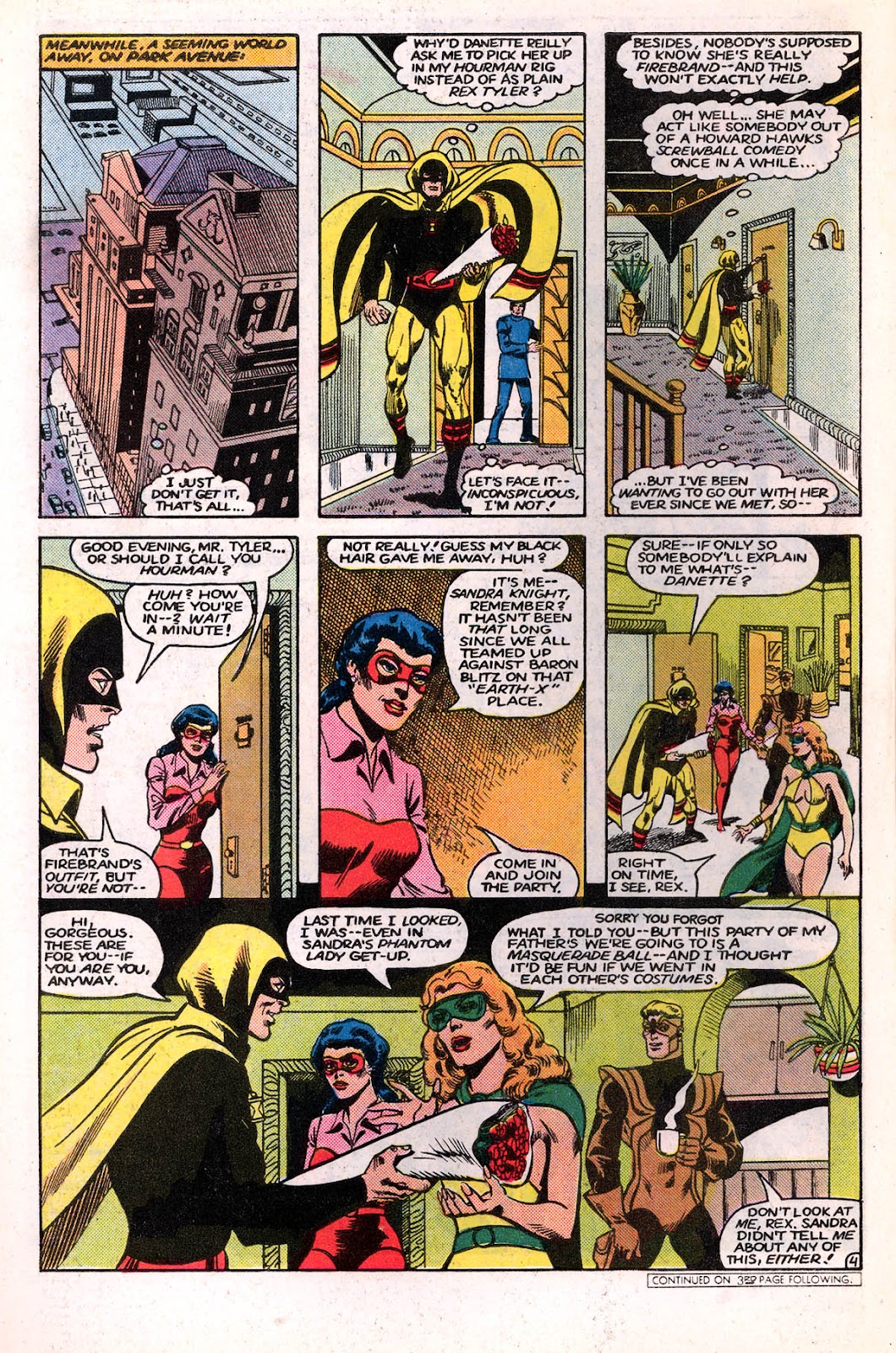
Turns out it is Sandra Knight and she and Danette have swapped costumes, for a party, while neglecting to inform Hourman or Tarantula (Phantom Lady's date). Danette is sporting Phantom Lady's rather revealing costume. They then inform the boys that they have to swap costumes (Tarantula and Hourman, not the boys with the girls...The New DC wasn't that radical!) So, get ready for some confusing imagery. Tarantula says he used his 5-day deodorant pad, which didn't exist in 1942. They arrive at Danette's father's place, with party in full swing...
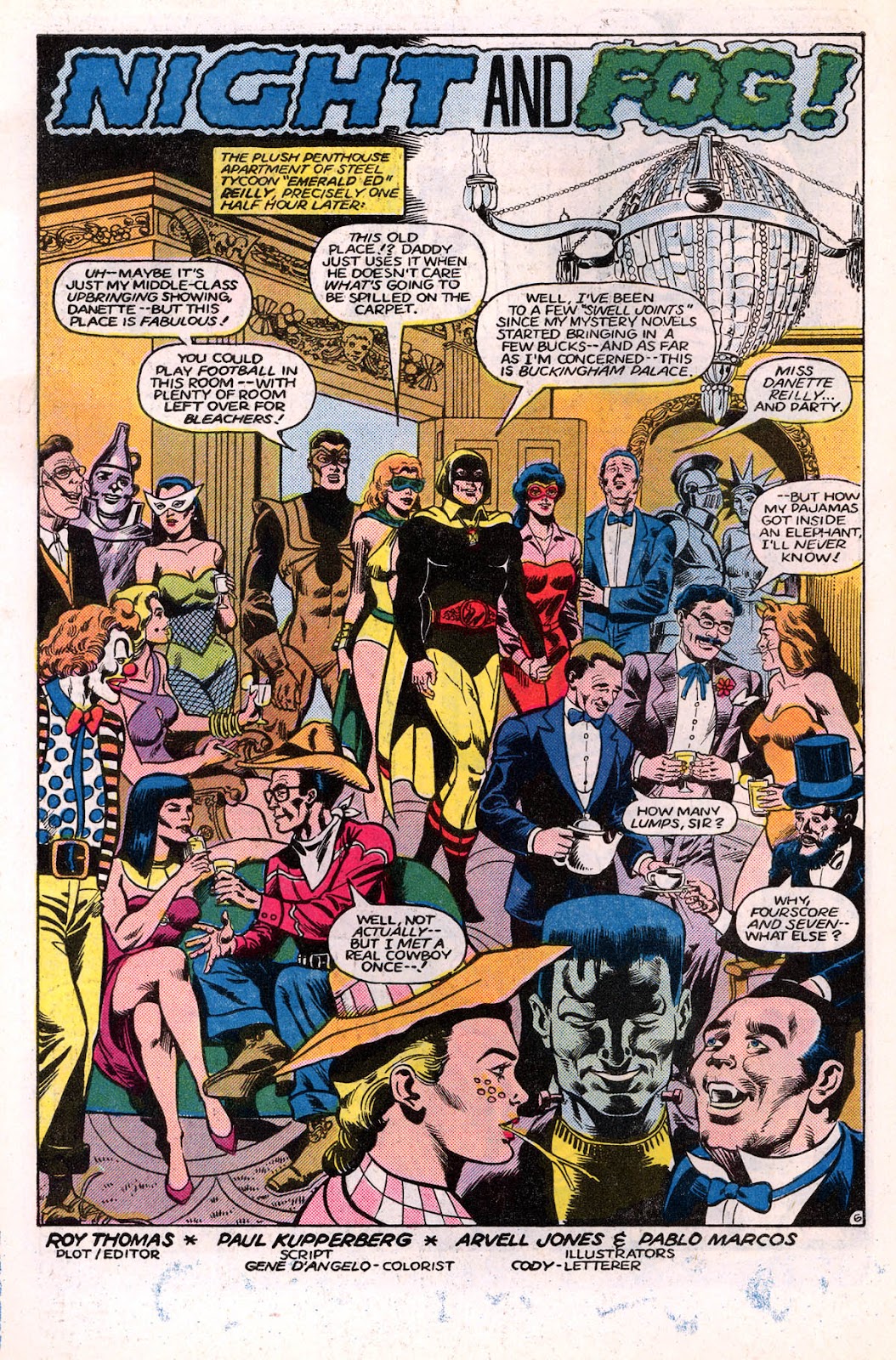
Roy thinks he can improve on George S Kaufman, Bert Kalmar, Harry Ruby and Morrie Ryskind (writers of the Marx Brothers' Animal Crackers). No sign of Mrs. Rittenhouse, The Professor or Signor Rivelli.
Danette introduces everyone to Daddy, who's decked out as a Civil War general (Union, of course) and he remarks about the skimpy nature of Phantom Lady's costume. He mentions to her that brother Rod and his buddy Slugger are being released from the San Francisco Navy hospital, where they have been since they were wounded at Pearl Harbor. Might we be seeing the original Firebrand soon?
Nah, probably not...
Daddy turns out to be a republican and isolationist and rails against FDR, the New Deal and the ridiculous idea that FDR maneuvered the Japanese into attacking the US.
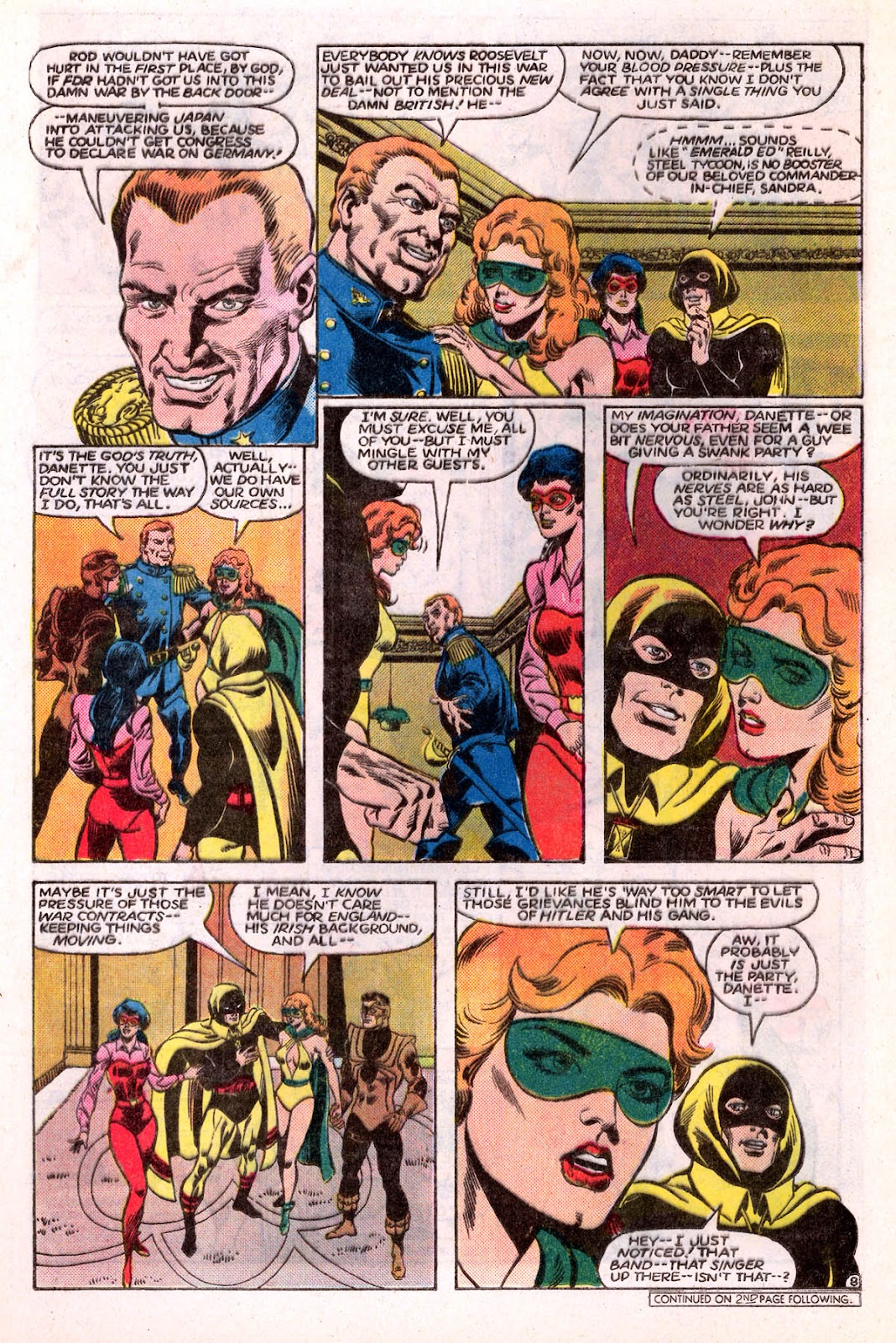
John Law (aka Tarantual, aka Hourman, for the party) notes that pops is acting a might twitchy, which even Danette says is true. They then notice the band...Tommy Dorsey, and the singer...Frank Sinatra. Sandra & John cut a rug (well, a slow dance, anyway) while Rex and Danette go out to the balcony to pitch a little woo. They run into a couple coming inside, the lady of which looks like she handles some of Ed Reilly's business associates, as special "private clients," whipping them into shape. Danette tells Rex to pitch away, but to hang back on his fastball. They dance a bit, as The Chairman of the Board tells us why he likes New York in June (how about you?). Our dominatrix lady and her companion corral Ed Reilly and they go into his study and we hear a German accent, while the band kicks into a jitterbug and John and Sandy show us how to jive and wail....
Ladies and Gentlemen, the one and only Dagwood and Blondie (Arthur Lake and Penny Singleton...Penny would later voice Jane Jetson)!
The German pair say something about Ed Reilly betraying the Allies, which he denies, then he gets whammied with some kind of black....um....stuff. Outside, Rex tries to move a little fast and Danette puts the breaks on, when Sandy and John turn up. They say something fishy is going on with the two people who went in the study with Ed. They go to check on him.
We find out that the couple are brother and sister, Nacht und Nabel (Night and Fog), named after Hitler's 1941 decree that enemies of the Reich should"disappear." Nazi scientists gave them power. Ed admits to slowing production while the US wasn't in the war; but, not since Pearl harbor.
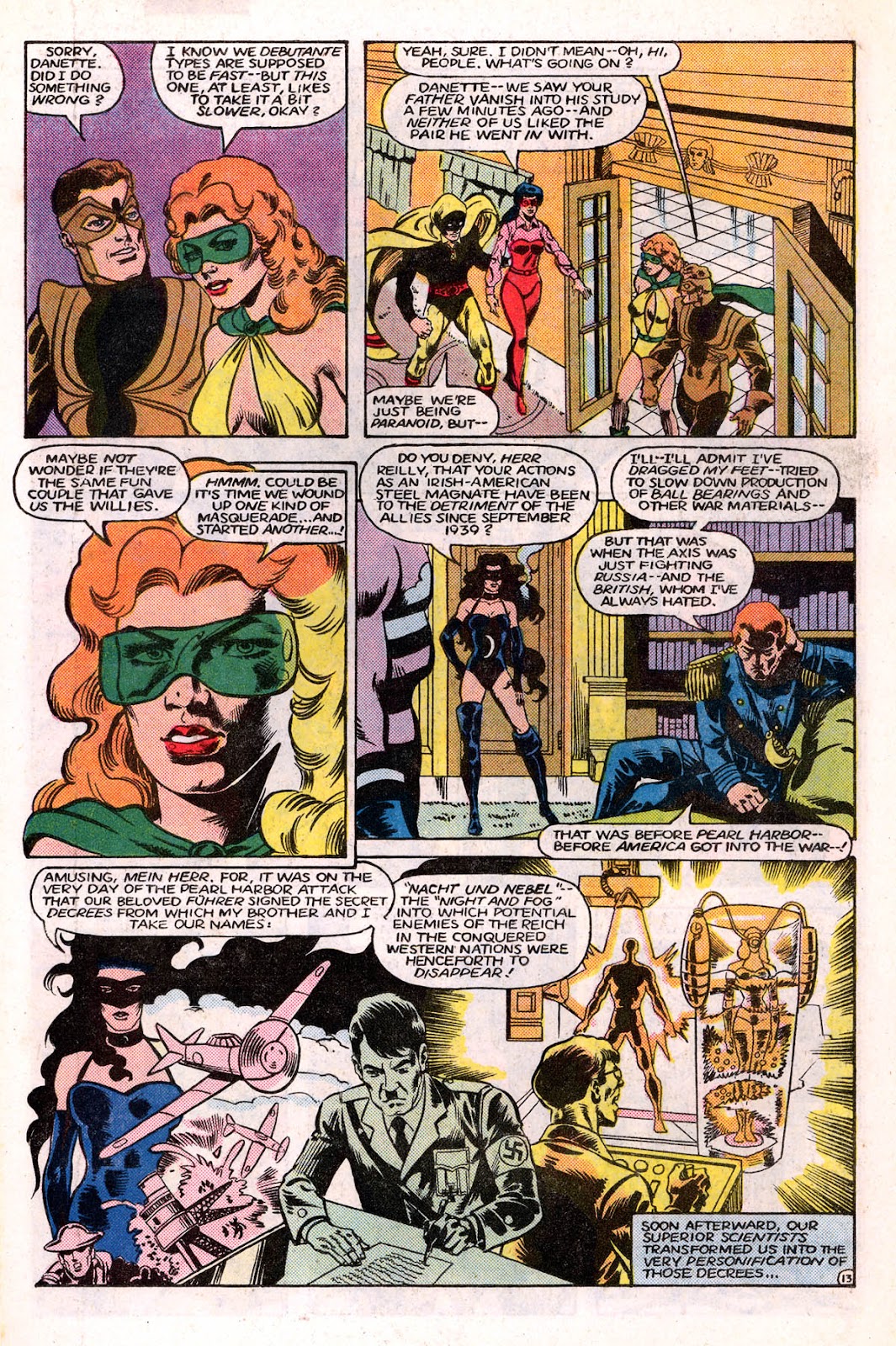
The dude is Nabel, who can turn into a numbing mist, while she is Nacht and they admit to being a bit kinky, as we see her standing behind some chained up guy, smirking. She says ol' Adolf personally sent them there to make sure Ed plays on their side. He tells them to go fly a kite and Nabel drops him out a window, just as the heroes come in. Danette, who is back in her own duds, leaps out after pops. Phantom Lady tries the blacklight ray against Nacht, but it doesn't work. Nabel KOs Hourman, but Tarantula gets in a haymaker. Nacht grabs him in her black field and Nabel finishes him. Firebrand saves pop, but they are out cold on a ledge. Hourman pops a Miraclo just in time to catch Phantom Lady, as Nabel throws her out the window. He struggles, because the Miraclo hasn't kicked in; but, when it does, he hauls her in and starts kicking ethereal matter.
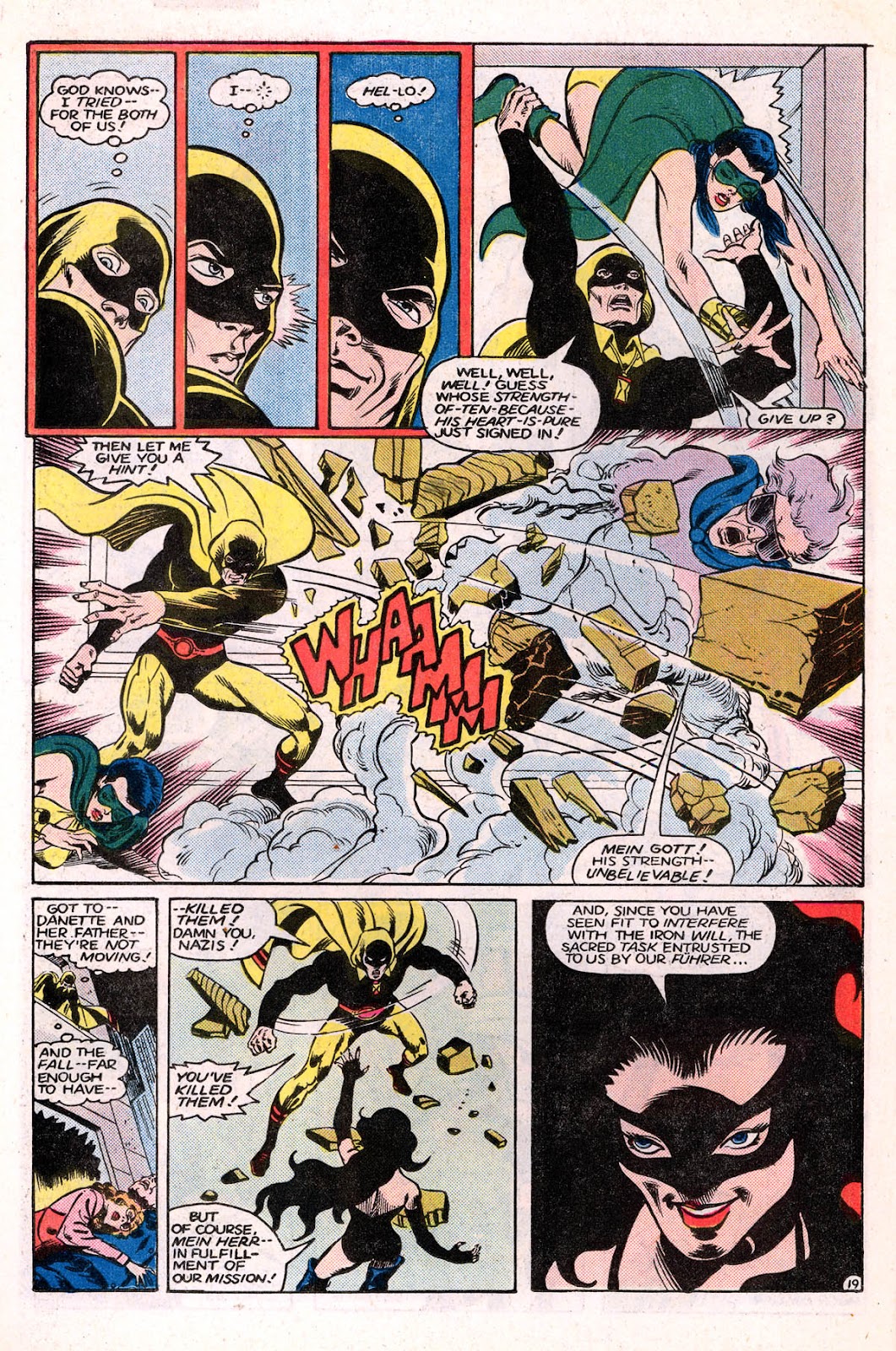
Nacht envelops Hourman in her inky field, while Ed Reilly dies in his daughter's arms and tells her the truth. Nabel freezes Hourman. Danette enters through the window and she is POed...
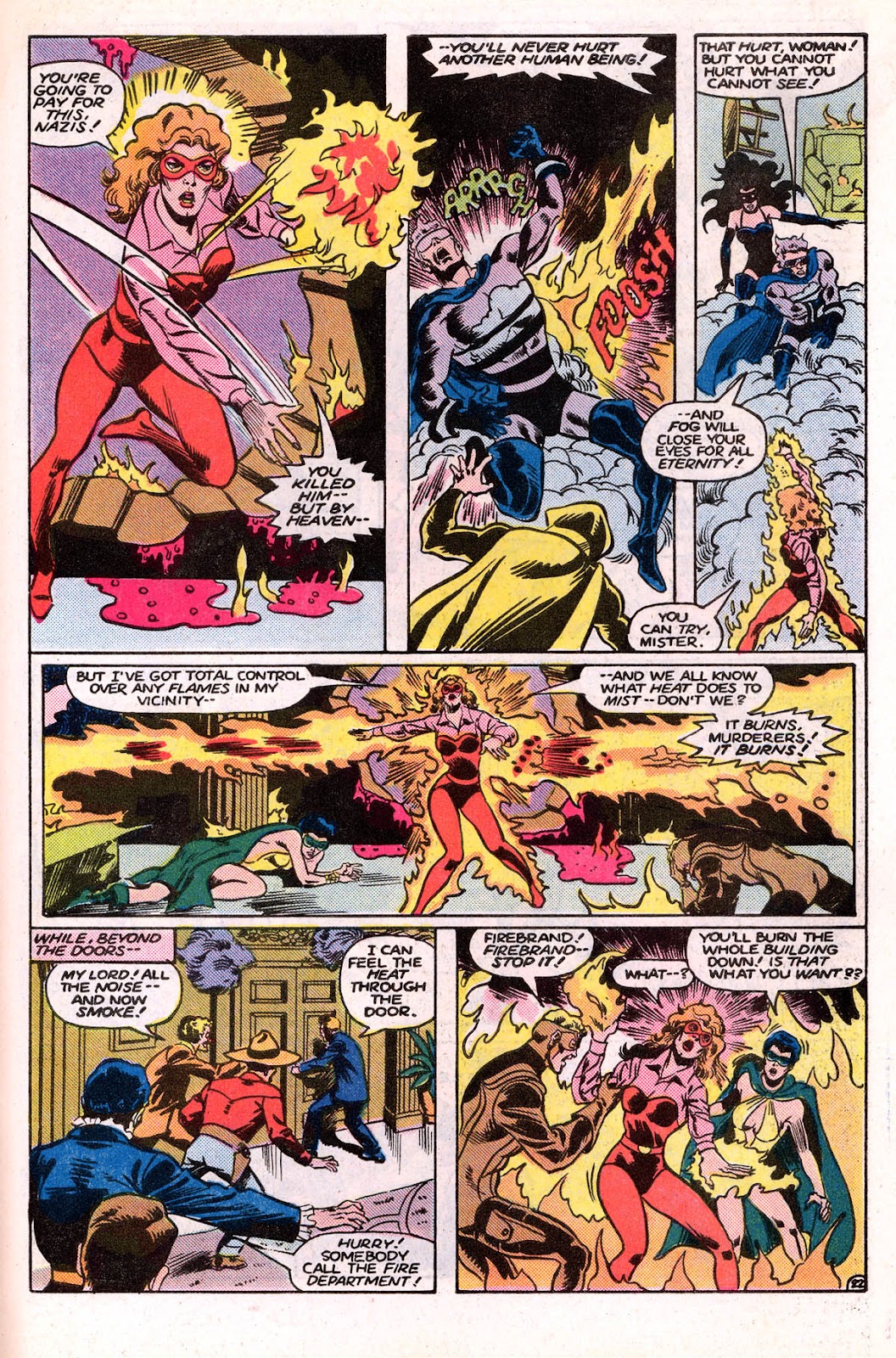
Firbrand reins in the collateral fire and Nacht und Nabel escape. Danette deals with the fuzz, while protecting daddy's rep.
Thoughts: Given the abrupt ending, I assume this is going somewhere, later. I don't know, there are nice character moments, but the main plot feels kind of light and slapped together. Roy is trying to make a point that some Irish supported Germany, because they were fighting Britain. Few problems with that, starting with Ireland being a republic, by that point, though they remained officially neutral. However, a lot of Irish served in the British Army and not just those from Ulster. There were also British fascists who supported Hitler, including people like Sir Oswald Mosley, who led the British Union of Fascists (which got him imprisoned in 1940, before being released in 1943).
(For the confused American, this is a spoof from British sketch comedy series Not the Nine O'Clock News, where some National Front neo-Nazis sing his praises, while satirizing the newspapers of the day who praised Mosley, until the war broke out, much as Hitler had been praised in some American newspapers, before 1939.)
This whole thing seems rather thin. The good stuff is the character interplay between the couples; but, everything else feels under-developed. Hopefully, Roy was just getting warmed up.
Night and Fog (Nacht und Nabel) aren't exactly Master Man and Warrior Woman, from the Invaders. He's not overly impressive and she gets most of the dialogue, with the same stereotypical dominatrix posturing. Why is it that the go-to for German female villain is dominatrix? Seriously, Paula Von Gunther, Warrior Woman, Night.......Comic people are a kinky lot! (not everyone, though we do have the Overstreet bondage cover notations, Marston's Wonder Woman, Phantom Lady's "headlights," the afore-mentioned dominatrices, a whole lot of stiletto heels and whips, and don't get me started on X-Men subplots). Then again, A whole lot more people read that horrid Twilight fan-fiction, masquerading as a BDSM "romance," that even the BDSM crowd disowned as creepy and abusive.
The next issue blurb says Baron Blitzkrieg is back; so, maybe things will pick up.
The letters page has praise from TM Maple for the Detroit story, followed by a John Bircher who trots out Right Wing "Commie plots in organized labor" propaganda, with his proof being a book from another Bircher and HUAC. Roy's dander rise, just a bit, though he takes the high road and defends his story, says he has nothing against the JBS (other than some run ins with a few members in '64), but also doesn't give HUAC and McCarthy a pass for crying Commies under the Bed, while trampling on civil rights. I suspect if this had been an indie company, Roy might have been a bit more pointed in his rebuttal, though Roy has never been a fireeater, like some of his contemporaries.
In his Meanwhile column, Dick Giordano says 1985 will be a big year for DC (50th Anniversary) and trumpets the upcoming Crisis on Infinite Earths, and the companion Who's Who in the DC Universe (which also got a house ad, earlier in the book).
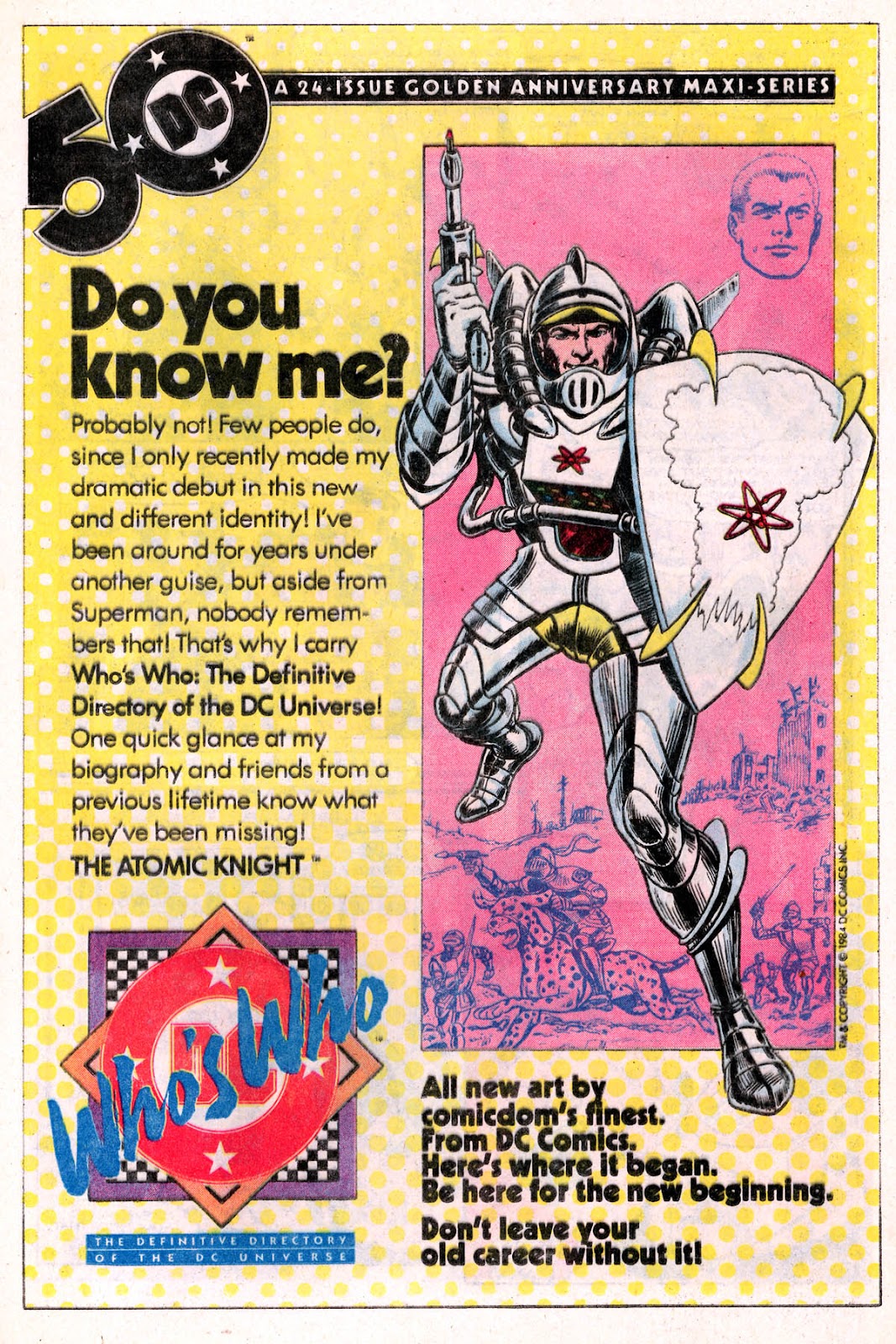
There was also a Crisis ad, which dropped the DC Universe prefix from the title, as seen in a previous ad (DC Universe: Crisis on infinite Earths)...
(earlier ad)

and new ad
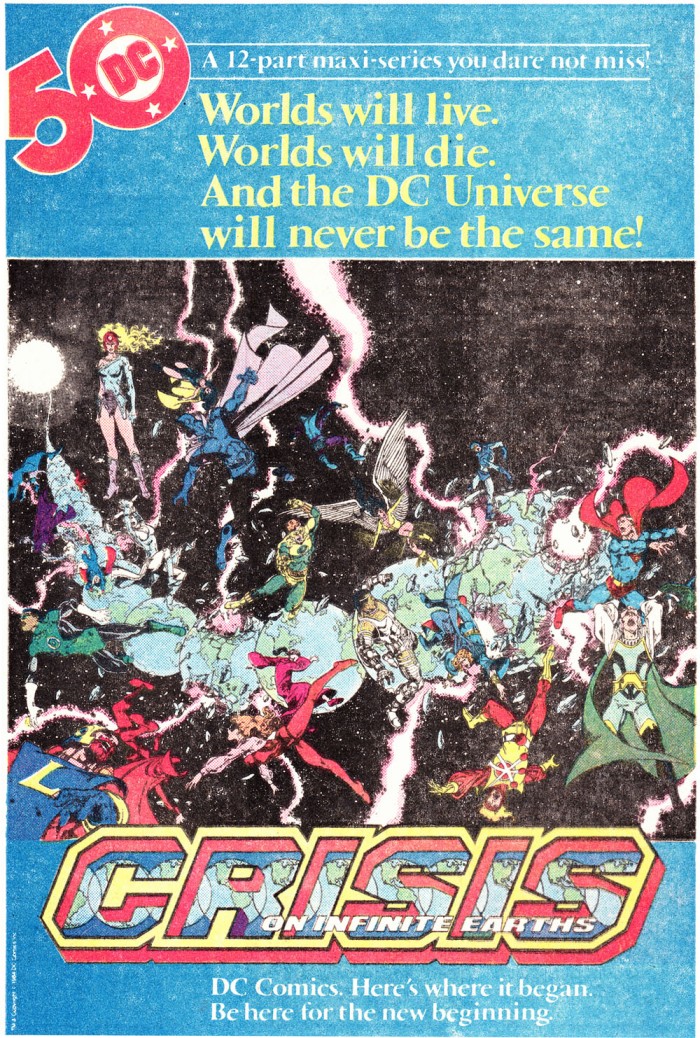 Historical Notes:
Historical Notes: Not too much in the issue, that I haven't already discussed, such as some American businessmen (such as Henry Ford) and newspapers supporting Hitler, early on, before the war, but not by 1939. We do see Tommy Dorsey and his orchestra, with Frank Sinatra as the singer, with a note of rumors of him striking out on his own.

Sinatra sang with Henry James' band, from June, 1939 to November of that year, leaving after being frustrated that he wasn't getting anywhere. He joined Dorsey's band that month and stayed until September, 1942, after a legal battle. he then signed as a solo artist with Columbia. Roy further notes that Bing Crosby was the only singer to make a go of going solo. Frankie was rivalling Bing, which spilt over into other media...
May 1943
On May 13, the Afrika Korps and its Italian allies surrender to the Allied forces, ending the war in North Africa. Now, all eyes turn toward the Invasion of Sicily. The day before saw the start of the Trident Conference, between FDR and Churchill, in Washington (The Third Washington Conference).
The Warsaw Ghetto Uprising ends, with 13,000 Jews killed and another 50,000 deported to the death camps of Treblinka and Majdanek.
Norman Rockwell's "Rosie the Riveter" cover adorns the Saturday Evening Post...
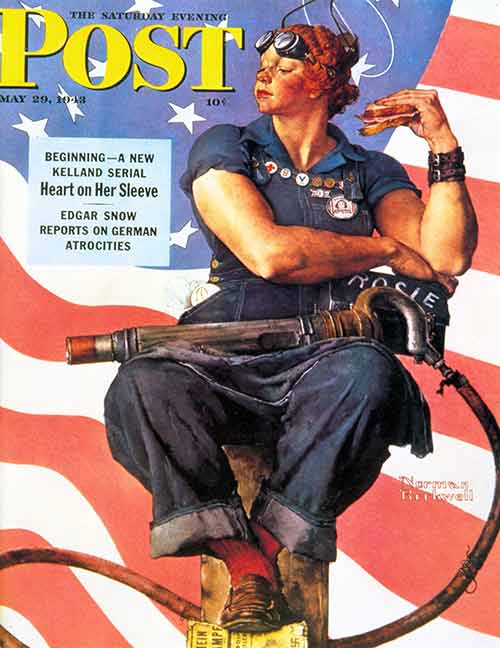
The USS New Jersey was commissioned. It would serve with the 5th Fleet, under Adm Raymond Spruance (who stood in for Halsey, at Midway) and took part in landings and actions at Kwajalein, in the Marianas (Tinian and Saipan), the Battle of the Philippine Sea (and the "Marianas Turkey Shoot"), the Philippines, and strikes on Formosa and Okinawa. She was decommissioned in 1948, then brought back in 1950 (decommissioned in 1957), 1968 (put back in mothballs in '69) and 1982, as part of Pres. Reagan's "600-ship Navy", and took part in a shore bombardment of Lebanon, in 1984. She was stood down in 1990 and struck from records in 1991, prior to operation desert Storm, ending the last gasp of the Battleship Era. On my first midshipman training cruise, I was on an oiler (a tanker) and we carried out underway refueling operations with the New Jersey battlegroup, where we refueled the ship, as well as the USS Enterprise. So, I got to see her sailing alongside (while working on maintaining the phone and distance line).
The Memphis Belle, a B-17 Bomber, became the first American aircraft to complete its 25 mission tour. The Eighth Air Force had suffered heavy casualty rates in bombing missions, prior to that, as pilots gained experience in flying combat missions, usually without fighter escort. The missions required tight formation flying, so that bombers could cover each other, with their .50 cal guns, as they headed for their targets. However, it would take the introduction of long range fighter escorts to achieve real success in the bombing campaigns, with the P-38 Lightning, P-47 Thunderbolt and the P-51 Mustang. The Belle was flown back to the US, by a composite crew and sent on a war bond tour. A documentary film was created in 1944 and a drama in 1990

The US Navy formed the first Underwater Demolitions Teams, which carried out beach reconnaissance and cleared landing obstacles, using demolition charges or other methods. These "frogmen" would become the forefathers of what, in the Vietnam Era, would become the US Navy SEALs (
SEa,
Air and
Land), though UDT was kept separate from the SEALs, until 1983, when they were integrated. Professional wrestler and former Minnesota Governor Jesse "The Body" Ventura was a UDT swimmer (UDT Team 12), and not a Navy SEAL as he liked to claim, in wrestling. He also never saw combat in Vietnam or anywhere else, other than a wrestling ring or a movie set.
The 7th Infantry landed on Attu, to drive off the Japanese occupiers. The American forces were ill-prepared for conditions and the fighting was savage, as the Japanese had no hope of being evacuated. Fighting ended after a massed banzai charge on May 29. The Japanese were killed nearly to a man.
Bulgaria caved under pressure from Germany to deport 25,000 Jews from Sofia; but, massive civil unrest ledt to them rescinding the order and keeping them as forced labor, instead.
Allied convoy operations had vastly improved, particularly with carrier support and Germany suffered it's heaviest losses, with 41 u-boats sunk in May. Adm Karl Donitz halted u-boat operations and redeployed them for other operations in areas without heavy air cover.
Dr Josef Mengele began his posting at Auschwitz, where he carried out medical experiments on prisoners. He escaped capture, after the war, fleeing to Argentina, then Paraguay and Brazil. Despite intense Mossad hunts and extradition requests from Israel and West Germany, he escaped capture and trial and eventually died of a stroke, in 1979 and was buried under a false name. His remains were eventually located and positively identified by forensic examination, in 1985. His escape and continued existence made him (and Martin Borman) a favorite of thriller writers, including Ira Levin, who made him the chief antagonist in his thriller, The Boys From Brazil, where Mengele has cloned Adolf Hitler and placed the children with carefully selected adoptive parents to simulate the childhood experiences of Hitler. The movie adaptation featured Gregory Peck as Mengele, with Laurence Olivier as Ezra (Yakov, in the novel) Lieberman, a Nazi hunter, based loosely on Simon Wiesenthal.
On May 16, RAF Squadron No. 617 took off from RAF Scampton, Near Lincoln, to attack German damns on the Ruhr and Eder Rivers. The aim was the destroy the dams and flood the Ruhr valley, which was the heart of German industrial activity. To do this, a special bomb was designed by Barnes Wallis, chief designer at Vickers, and then tested. The problem of destroying the dams was that bombing the dams themselves didn't necessarily create enough damage to cause mass flooding. Experiments showed that a massive bomb would be required, but no plane existed that could carry it. Instead, they hit upon the idea of exploding a bomb at the base of the dam, which could cause enough damage for the natural water pressure on the dam to force it to break apart and release the millions of gallons of water. Wallis had originally intended the bomb for anti-shipping use. The actual bomb was a cylinder, which was spun at a specific rate, dropped at a specific altitude and speed, at a certain point, causing it to bounce across the river and explode at the correct point. This required the bombers to come in at a specific approach and maintain speed and then release the bomb at the correct altitude and distance.
Wing Commnader Guy Gisbon, who was 24 (but had flown 170 bombing missions) was put in charge of the squadron as they trained and developed their tactics and worked out the problems of identifying the drop point. Spotlights were mounted under the aircraft which would merge together, when the plane was at the correct altitude. Distance was measured via several methods, though one involved a two-pronged sight, to line up on towers of the damn; however, a later BBC documentary revealed that this was not actually used on the raid, despite appearances in the movie dramatization. 8 aircraft were lost on the mission (out of 19). After a succession of attacks, the Mohne Dam, on the Ruhr was breached. The Eder Dam did not have anti-aircraft installations, but heavy fog and topography made bombing difficult. However, it, too, was successfully breached. The Sorpe Dam was also attacked , but it was an earth dam and more difficult to breach and a hit on it failed to do so. The Ennepe Dam also survived an attempt.
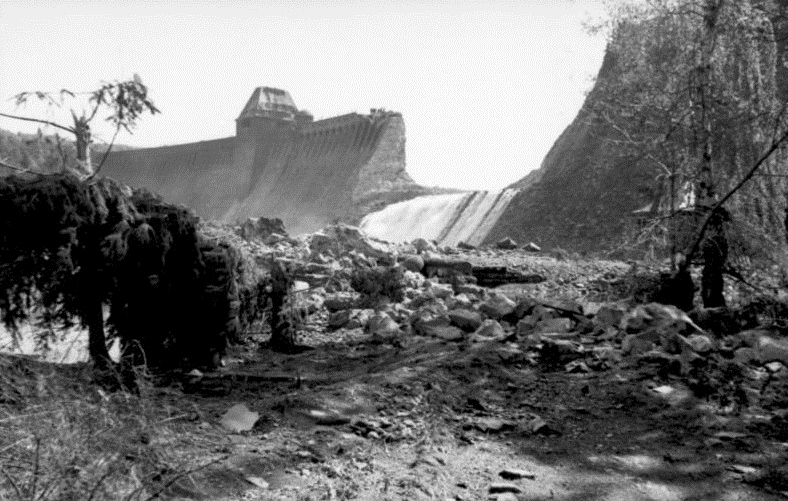
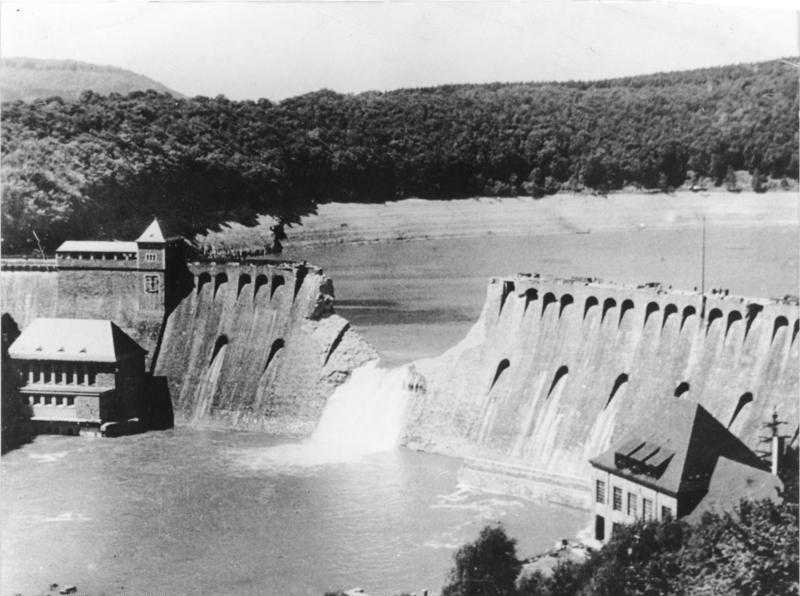

A Spitfire reconnaissance plane was launched at 07:30, on May 17, to photograph the damage, which showed the flooded areas. The damage did disrupt coal mining and steel production, by 1/4; but, failure to follow up on the destruction or to bomb the reconstructed dams made the loss minimal. The loss of hydroelectric power had a greater affect than the actual flooding.
The raid, which became known as the Dambuster Raid (Operation Chastise, officially) and would inspire the classic British war movie, The Dam Busters, starring Richard Todd as Guy Gisbon and Michael Redgrave as Barnes Wallis. There are fallacies in the film, but, the basic details are relatively accurate. It also has a troubling element, as Gibson owned a black labrador retriever, with a rather unfortunate ethnic slur for a name (the N-word) and that has led to some censorship of the film, in some markets and editions. The dog was a kind of mascot for the squadron and was hit and killed by a vehicle, on the morning of the raid. His name was used as a code word to signal that the Mohne Dam had been breached.
The basic mission and dialogue during the attack run would later inspire the Death Star attack, in Star Wars (along with the similar film 633 Squadron, about a Mosquito bombing mission against a German V-2 Rocket plant, in Norway).
At one point, a new film was being developed about the raid, with a script by Stephen Fry, to be produced by Peter Jackson. It has gone through many stops and starts and remains unproduced. The dog controversy was addressed by renaming the animal, or using a diminutive nickname that eliminates most of the slur, but would probably not pass muster, in the current climate (remove the second syllable and add "sy", for the nickname, sometimes used by Gibson).